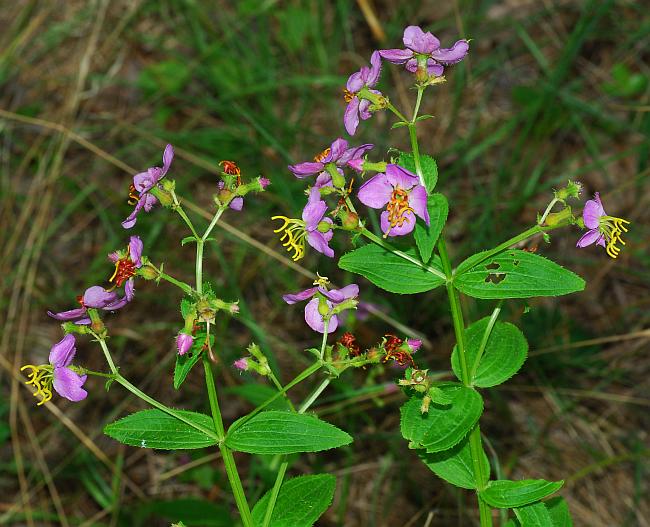Rhexia virginica L.
Wing-Stemmed Meadow Beauty

Native
CC = 6
CW = -5
MOC = 18
© SRTurner
Rhexia virginica L.Wing-Stemmed Meadow Beauty | |
 |
Native CC = 6 CW = -5 MOC = 18 |
© SRTurner |
|
Family - Melastomataceae Habit - Perennial forb, usually without rhizomes, usually with small tubers on roots. Stem - 100 cm long, more or less equally 4-angled, the angles noticeably winged, the wings mostly 0.3-2.0 mm wide, sparsely to moderately glandular-hairy at the nodes, the internodes pubescent with similar hairs to nearly glabrous.
Leaves - Opposite, simple, sessile. Blades 2-7 cm long, elliptic or more commonly ovate, becoming narrowly ovate toward the stem tip, sharply pointed, glabrous or more commonly sparsely to moderately glandular-hairy, the margins sharply and finely toothed.
Flowers - Perfect, with the perianth actinomorphic and the stamens and to some extent the pistil zygomorphic. Hypanthium tubular at flowering, persistent and becoming urn-shaped as the fruit matures, extended past the ovary as a short necklike tube, glabrous to moderately glandular-hairy. Calyces of 4 free lobelike sepals at the hypanthium tip, these 2-4 mm long, triangular, sharply pointed at the tip, persistent at fruiting. Corollas of 4 free petals, these 15-20 mm long, spreading, often with sparse glandular hairs on the outer surface and margins, usually broadly obovate, rounded, pink to rose-purple. Stamens 8, strongly exserted at flowering, subequal in size, S-shaped and curved downward, the anthers 5-8 mm long, attached just above their bases, strongly curved outward, yellow, dehiscing by terminal pores. Pistil of 4 fused carpels, inferior (but often appearing superior at fruiting). Ovary 4-locular, the placentation axile. Style 1 per flower, somewhat curved downward, about as long as the stamens, the stigma depressed-capitate to somewhat disc-shaped, entire or nearly so. Ovules numerous.
Fruits - Capsules, urn-shaped with the neck usually longer than the body, 7-10 mm long. Seeds numerous, 0.4-0.7 mm long, flattened and spiral-shaped (snail-shell-shaped), the surface brown, with several concentric, spiral ridges along the sides and especially along the keel, these varying from smooth to warty or tubercled.
Flowering - June - October. Habitat - Fens, acid seeps, sandy streambanks, wet depressions of sand prairies and sandstone glades, fields, ditches, roadsides, railroads, and moist sandy open disturbed areas. Origin - Native to the U.S. Lookalikes - R. mariana. Other info. - This attractive plant is found in Missouri mostly in the Ozark region, with a few additional populations toward the southwest corner of the state. The North American distribution is scattered in the eastern half of the continental U.S., and extends into Canada as well. Photographs taken off Macon County Rd 47, Macon County, AL., 8-30-04 (DETenaglia); also at Taum Sauk State Park, Iron County, MO, 09-27-2010, 07-18-2011, and 07-23-2018 (SRTurner). |